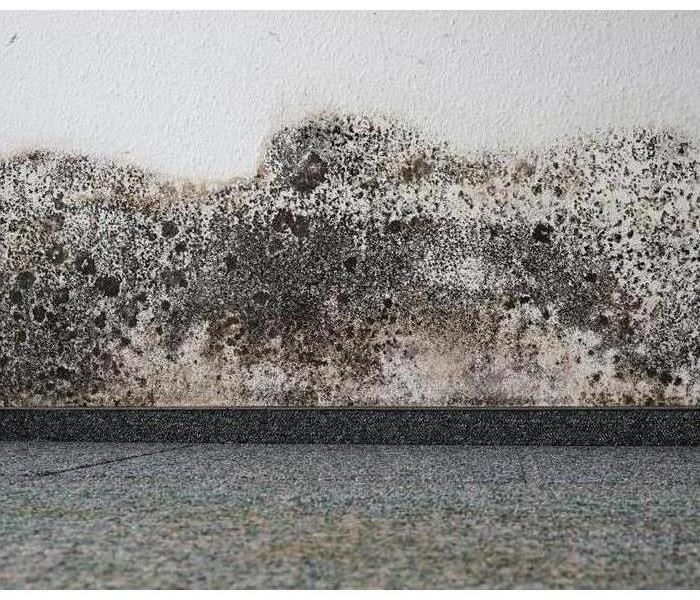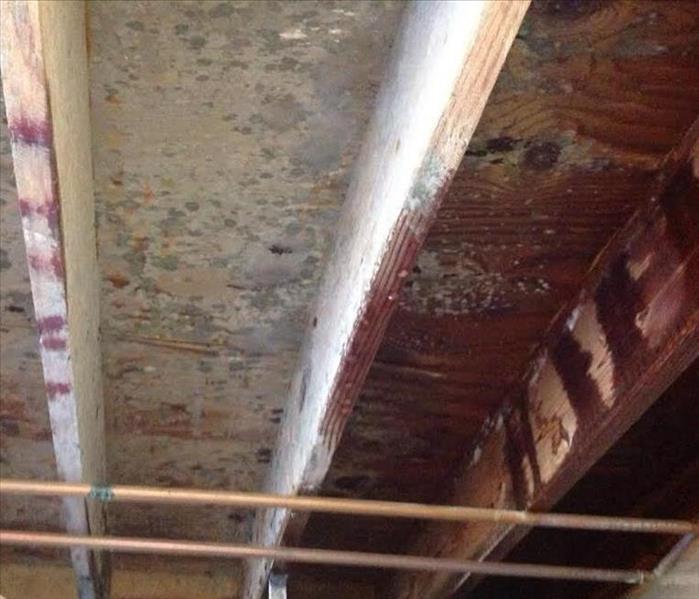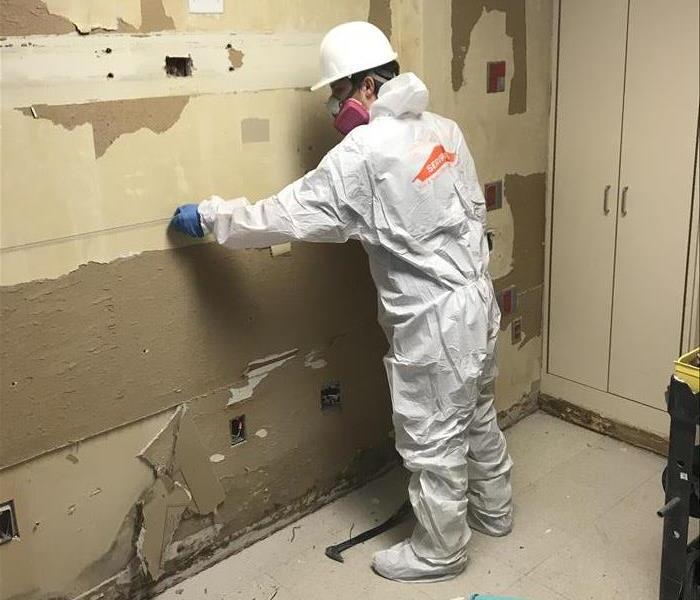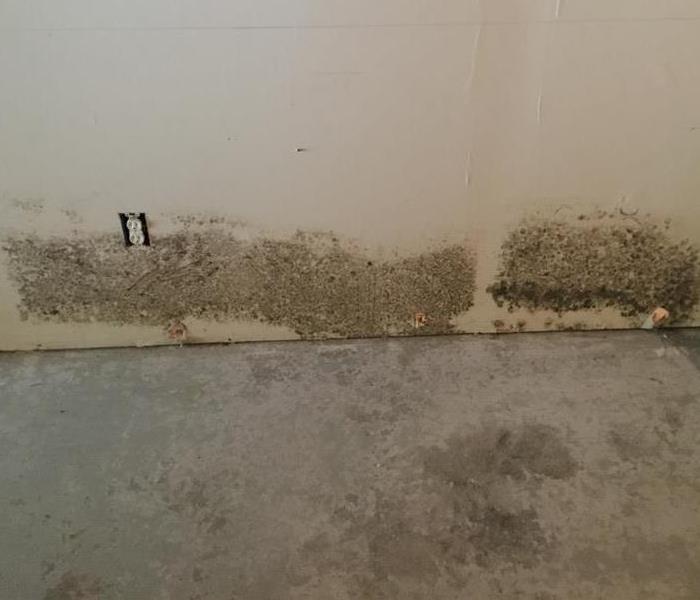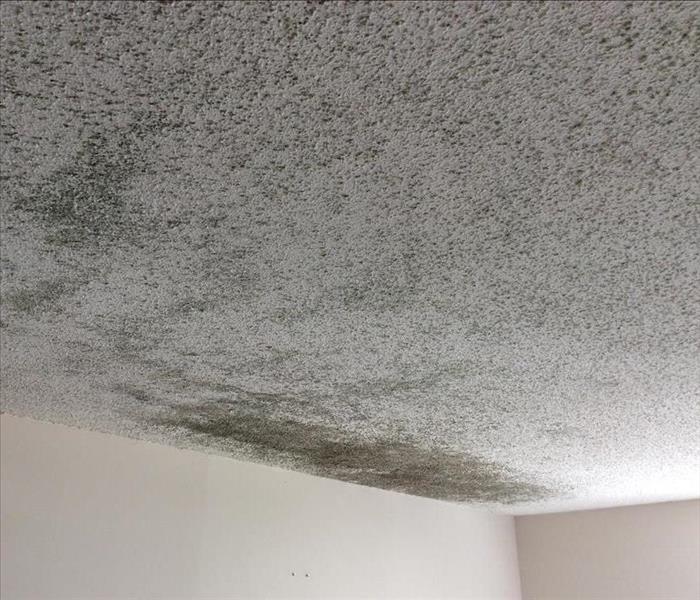Recent Mold Remediation Posts
Mold, Mold, Go Away... Come Again, Never.
12/1/2021 (Permalink)
We have all experienced food going bad at some point and mold growing on foods that we have not touched in a long time. However, how can we prevent food from going moldy? Buying small amounts and using food quickly is probably the best way to prevent mold growth in food. However, there are other practices that you can implement to prevent mold growth in food.
- Examine food well before you buy it. Check food in glass jars, look at the stem areas on fresh produce, and avoid bruised produce.
- Fresh meat and poultry are usually mold free, but cured and cooked eats might not be. Examine them carefully.
- When serving food, keep it covered to prevent exposure. Use plastic wrap to cover foods you want to stay moist.
- Empty opened cans of perishable foods into clean storage containers and refrigerate them.
- Be mindful of how long an item can stay in the fridge.
Cleanliness is the key to controlling mold. Mold spores from contaminated food can build up in your refrigerator, dishcloths, and other cleaning utensils. - Clean the inside of the refrigerator every few months with one tablespoon of baking soda dissolved in a quart of water. Rinse with clear water and dry. If you do run into mold, scrub the visible mold (usually black) on rubber casings using three teaspoons of bleach in a quart of water.
- Keep towels, sponges, and mops clean and fresh. A musty smell means they are spreading mold around. Discard them if you cannot use them.
What Happens If You Discover Mold?
5/10/2021 (Permalink)
DID YOU KNOW?
- Mold will grow in places with a lot of moisture, such as around leaks in roofs, windows, and anywhere there has been flooding.
- Whenever mold drops on anything that has excessive moisture, it will grow. Check basements and places that hold a lot of moisture in your home, often to ensure no mold is present.
Here are some tips if you discover mold within your home or around your home.
What to Do:
- Stay out of affected areas.
- Turn off the HVAC system and fans.
- Contact SERVPRO of Birmingham for mold remediation services.
What Not to Do:
- Don’t touch or disturb the mold.
- Don’t blow air across any surfaces with visible or suspected mold growth.
- Don’t attempt to dry the area yourself.
- Don’t spray bleach or other disinfectants on the mold.
If you and your family have found mold growing in or around your home, the best decision to make is to call SERVPRO in order to resolve the issue quickly and efficiently. SERVPRO has the training, protective gear, and specialized equipment to handle your mold problem. Mold, like mentioned above, can cause numerous health effects and cause damage to your home.
Call SERVPRO (205) 664-6770
1. Assessment:
Your property will be carefully inspected using technology that can detect mold.
2. Containment
Then, containing the mold will be the top priority, in order for it not to spread any further.
3. Air Filtration
Specialized equipment captures any mold that remains in the air.
4. Removing
Any mold growth, is removed using anti-fungal treatments.
5. Cleaning & Restoration
SERVPRO cleans all furniture, clothing, walls, etc. with chemicals to ensure the mold will not return. Lastly, if anything in your home needs restored SERVPRO will repair those items.
Salvaged Items After a Mold Damage
7/20/2020 (Permalink)
Did you know Mold can grow on more than just your walls?
It can grow on a variety of items, from furniture to walls to wood and flooring. When it comes to mold cleaning, however, you may be surprised about the number of objects that can be salvaged when you know the steps for cleaning them properly.1. Leather Goods
Leather bags, jackets, and other items may be salvageable if you remove them from the affected area quickly. Because mold tends to spread faster in areas with high humidity, you can perform mold remediation for these items by transferring them to a room that is cool and dry. Once the leather has dried, you can sponge the surface with diluted baby soap to wipe away visible mold. Suede goods may need to be treated by a mold cleanup and restoration company.2. Clothing
While not all clothing can recover from mold damage, you may be able to salvage some items. An Esporta Machine, which is designed to clean cotton clothing affected by mold, smoke, and other substances, can be effective in removing mold. You may be able to soak some fabrics in diluted vinegar to remove the mold, but this depends on how fragile the fabric is. Your restoration experts may able to advise you about other mold cleaning processes.3. Paintings
Paintings affected by mold require special treatment. You may want to remove any wooden framing, as mold is attracted by wood fibers. Store the painting flat, away from humidity and sunlight, before contacting a professional artwork restoration company. Avoid bagging or sealing it in any kind of tight container, as this may create humid conditions that could encourage further mold growth. What to do...
When you find mold growth on your belongings, you may not know where to begin with mold cleaning. Contacting SERVPRO of Birmingham for removing your items from areas where mold is present. Our team can help you salvage irreplaceable items and proceed with the rest of the cleanup with confidence.
Got Mold?
7/22/2019 (Permalink)
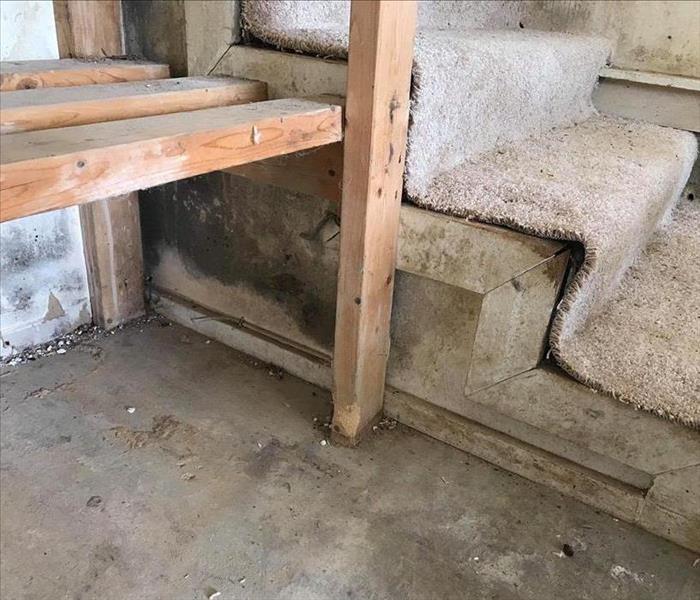 This home in Birmingham, AL found mold growth in their garage
This home in Birmingham, AL found mold growth in their garage
Mold can be in your home and not even realize it. Whether you see the affected areas or not, here are a few things you can do! First, if you see visible mold, do not mess with it. When mold is disturbed, it can release microscopic mold spores. When this happens mold can circulate inside your home using your HVAC system and any fans you have on. This makes it so the affected areas grow and become larger. Check out what to do and not do.
What Should You Do:
- Stay out of affected areas.
- Turn off the HVAC system and ALL fans.
- Contact SERVPRO® of Birmingham for mold remediation services.
What Should You Not Do:
- Don’t touch or disturb the mold.
- Don’t blow air across any surfaces with visible or suspected mold growth.
- Don’t attempt to dry the area yourself.
- Don’t spray bleach or other disinfectants on the mold
SERVPRO® of Birmingham specializes in mold remediation. We use specialized equipment and techniques to properly clean and resolve your mold problem quickly and safely. The safety and health of you and your family are our biggest concern. If you have mold in your home or business, give SERVPRO® of Birmingham a call at 205.252.8110
Dealing with Mold
12/21/2018 (Permalink)
When there is water in your home, mold can quickly become an issue. It can cause health issues and damage to your property. SERVPRO of Birmingham has the training, protective gear, and specialized equipment to handle your mold problem.
Call SERVPRO of Birmingham
The mold cleanup and restoration process begins when you call us. One of our employees will ask a series of questions to help determine the necessary equipment, resources, and personnel needed.
Assessment
Your property will be carefully inspected for signs of mold using various technologies to detect mold and hidden water sources. Mold feeds on cellulose and water and can be hidden from plain view.
Containment
Different containment procedures will be placed to prevent the spread of mold, like negative air chambers to isolate the contaminated area with physical barriers and negative air pressure to keep the mold spores from spreading during the cleanup process.
Air Filtration
Specialized filtration equipment captures microscopic mold spores out of the air. SERVPRO of Birmingham technicians use powerful air scrubbers and HEPA vacuums to prevent the spread of these mold spores while the mold remediation is in progress.
Removing
The process of mold remediation depends on the amount of mold growth and the type of surface it's on. Anti-fungal and antimicrobial treatments will be used to eliminate mold colonies and help prevent new ones from forming. Removing and disposing of mold-infested porous materials, like drywall and flooring, may be necessary.
Cleaning
SERVPRO of Birmingham cleans your furniture, decorative items, curtains, and other restorable items affected by mold. We use a variety of cleaning techniques to clean and sanitize your belongings.
Restoration
Depending on the level of mold damage, some building materials may have to be removed. Restoration may involve minor repairs or major repairs such as reconstruction.
Tips for Protecting Yourself from Mold During Cleanup
12/21/2018 (Permalink)
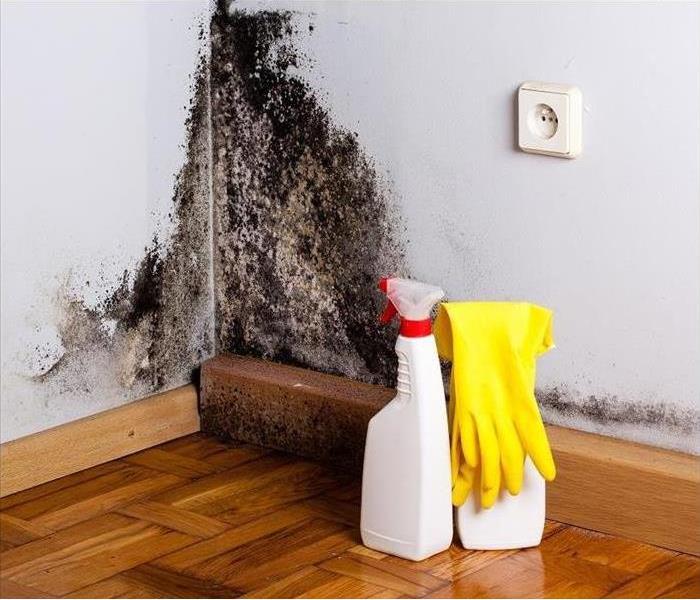 Mold damage clean up in Birmingham, AL
Mold damage clean up in Birmingham, AL
Tips for Protecting Yourself from Mold During Cleanup
During the process of mold remediation, it’s important to protect yourself, and your staff, with the proper safety gear and equipment. If you’re concerned about conducting the procedure yourself, SERVPRO of Birmingham mold remediation specialist may be able to help. The recommendations for a safe cleanup remain the same for everyone involved.
1. Wear Protective Clothing
When cleaning up mold growth it’s important to wear protective clothing. A coverall suit is recommended in most cases, but long sleeves tucked into gloves, and long pants may work just as well. Protective gear is an important tool for keeping any cleaning agents and mold spores off of your skin. If wearing everyday clothing instead of a protective suit, it’s important to launder them in hot water immediately after use.
2. Change Before Entering an Uncontaminated Area
Another way to protect your business is to change out of your safety gear before entering uncontaminated areas. This can help prevent the spread of mold spores into areas where mold growth has not yet occurred. The necessity of changing gear is why many professional use covers for their hair and shoes, as well as wear protective over-suits.
3. Wear a Mask and Goggles
The use of a respirator mask and protective goggles are also recommended. These can help prevent the inhalation of any cleaning fumes, and keep dust or debris common to clean up out of your eyes. The mask and goggles should fit snugly without pinching.
Using the proper equipment when cleaning up mold can help protect everyone, including the cleanup crew and the employees who regularly work in the building. Proper gear can not only help prevent the spread of mold to uncontaminated areas but allow for cleaning solutions to be used safely. If you’re unsure about the proper procedure or don’t want to conduct the cleanup yourself, a professional may be able to help.
Do you have Mold?
12/14/2018 (Permalink)
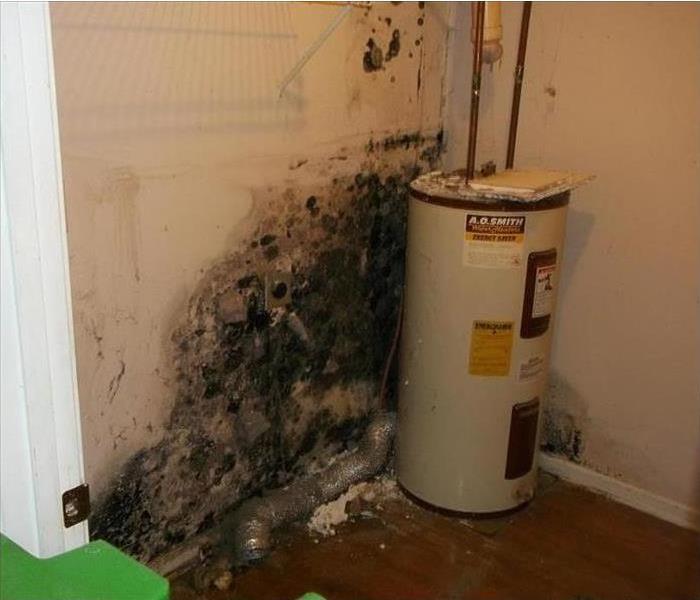 Mold can spread through quickly through a home in as little as 48 hours, in the Birmingham Area!
Mold can spread through quickly through a home in as little as 48 hours, in the Birmingham Area!
Microscopic mold spores naturally occur almost everywhere, both outdoors and indoors. This makes it impossible to remove all mold from a home or business. Therefore, mold remediation reduces the mold spore count back to its natural or baseline level. Some restoration businesses advertise “mold removal” and even guarantee to remove all mold, which is a fallacy. Consider the following mold facts:
- Mold is present almost everywhere, indoors and outdoors.
- Mold spores are microscopic and float along in the air and may enter your home through windows, doors, or AC/heating systems or even hitch a ride indoors on your clothing or a pet.
- Mold spores thrive on moisture. Mold spores can quickly grow into colonies when exposed to water. These colonies may produce allergens and irritants.
- Before mold remediation can begin, any sources of water or moisture must be addressed. Otherwise, the mold may return.
- Mold often produces a strong, musty odor and can lead you to possible mold problem areas.
Even higher-than-normal indoor humidity can support mold growth. Keep indoor humidity below 45 percent.
If your home or business has a mold problem, we can inspect and assess your property and use our specialized training, equipment, and expertise to remediate your mold infestation.
If You See Signs of Mold, Call Us Birmingham! 205-664-6770
Safety Environmental
10/5/2018 (Permalink)
Fungal organisms can grow and multiply wherever suitable conditions of moisture and a food source exist. Common sources of indoor moisture that may lead to mold problems include flooding, leaky roofs, plumbing leaks, overflow from sinks or sewers and damp basements or crawl spaces. Warping floors and discoloration of walls and ceilings can be indications of moisture problems. Unchecked moisture problems can lead to extensive mold contamination in your home, workplace or school.
- American Industrial Hygiene Association (AIHA-LAP) Proficient Mold Laboratory
- Preliminary Indoor Mold and Bacterial Assessments
- Post Remediation Mold and Bacterial Assessments
- Black Water/Sewage Screen Assessments
- Cause and Origin Insurance Assessments
- Remediation Project Management/Oversight
- Remediation/Design Specifications
- Food Service Assessments
If mold spore concentrations are high, people can become sensitized and develop allergic reactions. Symptoms of mold-overexposure include respiratory problems, eye irritation and skin rashes. In addition, if mold growth is left unchecked, structural damage to the facility can occur.
Safety, Environmental Laboratories and Consulting Services, Inc. specializes in assessing mold growth and contamination. We have performed indoor air quality assessments for residences, businesses and schools throughout the United States. In addition, we can make recommendations for the remediation of your mold problem and perform turnkey project management to insure the problem is corrected.
selcinc.com
Defense Against Mold Growth
7/24/2018 (Permalink)
Keep the humidity between 30 to 60 percent.
Provide for proper drainage away from building foundations.
Regularly inspect plumbing and appliances for leaks.
Keep gutters and drains clear of debris.
Respond to all water intrusions immediately.
Inspect the roof, windows and other areas where water might enter the building and perform necessary maintenance.
Contact SERVPRO® of Birmingham South for assistance after a water damage or if you discover mold.
Indoor Air Quality in Birmingham South
4/12/2018 (Permalink)
Indoor air quality/environmental professionals evaluate the quality of the air inside a structure. Some specialize and are skilled in testing buildings for the presence of molds. Using various testing devices, these professionals collect air and surface samples to compare the indoor mold spore count to the outdoor environment. If you have concerns about mold, SERVPRO of Birmingham South can assist you in locating a qualified indoor air quality/environmental professional.
SERVPRO of Birmingham South cares about proper restoration of your structure. In most water damage situations excessive mold growth is not a problem and SERVPRO of Birmingham South can safely restore your building to preloss condition. The need to address the presence of mold can be determined by an on-site, indoor environmental inspection. Please keep in mind SERVPRO of Birmingham South does not interpret insurance policies or coverage; you must consult your insurance company to determine the scope of policy coverage.
Mold in Schools
4/9/2018 (Permalink)
Since SERVPRO of Birmingham South covers two large counties, we have quite a few school systems in the area. Because of the relationships we have formed with them, they are able to call us if they have any issues that their maintenance staff can not handle. They following information from https://www.epa.gov/ are reasons why you might find mold in schools and how to handle it. We get calls all the time for water and fire damages, but also for mold. If you suspect mold in your home, business or place of work - give us a call today!
Common Moisture Sources Found in Schools
Moisture problems in school buildings can be caused by a variety of conditions, including roof and plumbing leaks, condensation and excess humidity. Some moisture problems in schools have been linked to changes in building construction practices during the past twenty to thirty years. These changes have resulted in more tightly sealed buildings that may not allow moisture to escape easily. Moisture problems in schools are also associated with delayed maintenance or insufficient maintenance, due to budget and other constraints. Temporary structures in schools, such as trailers and portable classrooms, have frequently been associated with moisture and mold problems.
Suggestions for Reducing Mold Growth in Schools
Reduce Indoor Humidity
- Vent showers and other moisture-generating sources to the outside.
- Control humidity levels and dampness by using air conditioners and de-humidifiers.
- Provide adequate ventilation to maintain indoor humidity levels between 30-60%.
- Use exhaust fans whenever cooking, dishwashing and cleaning in food service areas.
Inspect the building for signs of mold, moisture, leaks or spills
- Check for moldy odors.
- Look for water stains or discoloration on the ceiling, walls, floors, and window sills.
- Look around and under sinks for standing water, water stains, or mold.
- Inspect bathrooms for standing water, water stains, or mold.
- Do not let water stand in air conditioning or refrigerator drip pans.
Respond promptly when you see signs of moisture and/or mold, or when leaks or spills occur
- Clean and dry any damp or wet building materials and furnishings within 24-48 hours of occurrence to prevent mold growth.
- Fix the source of the water problem or leak to prevent mold growth.
- Clean mold off hard surfaces with water and detergent, and dry completely.
- Absorbent materials such as ceiling tiles, that are moldy, may need to be replaced.
- Check the mechanical room and roof for unsanitary conditions, leaks, or spills.
Prevent moisture condensation
- Add insulation to reduce the potential for condensation on cold surfaces (i.e. windows, piping, exterior walls, room, or floors).
Floor and carpet cleaning
- Remove spots and stains immediately, using the flooring manufacturer’s recommended techniques.
- Use care to prevent excess moisture or cleaning residue accumulation and ensure that cleaned areas are dried quickly.
- Do not install carpeting in areas where there is a perpetual moisture problem (i.e., by drinking fountains, by classroom sinks, or on concrete floors with leaks or frequent condensation).
Mold Remediation
2/6/2018 (Permalink)
SERVPRO of Birmingham South offers mold remediation and restoration; we have the training, equipment and expertise to better assist you.
I spoke with our Mold and Biohazard Manager to ask him some questions about how this process works.
It is preferred that you have an Industrial Hygienist protocol done.
What is that?
This is a process where air sampling and affected areas are tested to provide a detailed remediation and restoration protocol for SERVPRO of Birmingham South to follow. There is also a post-test that will take place once we are finished to confirm clearance.
Every time our team handles a mold job, we are required to wear the appropriate PPE (Personal Protective Equipment) which includes items such as coveralls and respirators.
SERVPRO of Birmingham South will make sure to keep anything deemed salvageable; we go above and beyond to ensure restoration before removal. Unfortunately, in most situations there is a some tear out involved to remove affected areas such as drywall, flooring, and/or furniture.
During the mold remediation process a HEPA vacuum is used, HEPA filters are designed to capture particles as small as mold spores and to insure that they do not get reintroduced. Our mold experts use “negative air” containment, which is created by positioning negative air machines to introduce clean air into the affected area and push contaminated air outside the home.
You want to consider getting your HVAC cleaned as well, the mold spores can collect there and be dispersed throughout the home.
Every mold infestation is different, from the amount of mold to the types of materials affected. Each scenario requires a unique solution, but the general process stays the same. If you have any questions, give us a call today; 205-664-6770.
Controlling Mold
12/15/2017 (Permalink)
You Can Control Mold
Inside your home you can control mold growth by:
- Controlling humidity levels;
- Promptly fixing leaky roofs, windows, and pipes;
- Thoroughly cleaning and drying after flooding;
- Ventilating shower, laundry, and cooking areas.
If mold is growing in your home, you need to clean up the mold and fix the moisture problem. Mold growth can be removed from hard surfaces with commercial products, soap and water, or a bleach solution of no more than 1 cup of household laundry bleach in 1 gallon of water.
Mold growth, which often looks like spots, can be many different colors, and can smell musty. If you can see or smell mold, a health risk may be present. You do not need to know the type of mold growing in your home, and CDC does not recommend or perform routine sampling for molds. No matter what type of mold is present, you should remove it. Since the effect of mold on people can vary greatly, either because of the amount or type of mold, you can not rely on sampling and culturing to know your health risk. Also, good sampling for mold can be expensive, and standards for judging what is and what is not an acceptable quantity of mold have not been set. The best practice is to remove the mold and work to prevent future growth.
If you choose to use bleach to clean up mold:
- Never mix bleach with ammonia or other household cleaners. Mixing bleach with ammonia or other cleaning products will produce dangerous, toxic fumes.
- Open windows and doors to provide fresh air.
- Wear non-porous gloves and protective eye wear.
- If the area to be cleaned is more than 10 square feet, consult the U.S. Environmental Protection Agency (EPA) guide titled Mold Remediation in Schools and Commercial Buildings. Although focused on schools and commercial buildings, this document also applies to other building types.
- Always follow the manufacturer’s instructions when using bleach or any other cleaning product.
www.cdc.gov
Industrial Hygienist
11/28/2017 (Permalink)
In some cases, our mold jobs need to be referred to an industrial hygienist. If you are like me then you're asking "what exactly is that and what do they do?"
According to www.aiha.org , "Industrial Hygiene is a science and art devoted to the anticipation, recognition, evaluation, prevention, and control of those environmental factors or stresses arising in or from the workplace which may cause sickness, impaired health and well being, or significant discomfort among workers or among citizens of the community."
They describe Industrial hygienists as "scientists and engineers committed to protecting the health and safety of people in the workplace and the community."
SERVPRO of Birmingham South does not do inspections but we can give you a quote on the visible substance you can SEE.
The steps listed below illustrate our process for a “typical” mold remediation infestation:
- Emergency Contact - (205) 252-8110
- Inspection and Mold Damage Assessment
- Mold Containment
- Air Filtration
- Removing Mold and Mold-Infested Materials
- Cleaning Contents and Belongings
- Restoration
Continuing Education
10/24/2017 (Permalink)
SERVPRO of Birmingham South has been hosting one continuing education class a month, this year in 2017. These classes are very popular with our insurance agents and adjusters, since they have to take a certain amount of hours to renew their licenses. Besides mold we touch on various topics which include Fire, Water, Biohazard Cleanup, and Ethics. The most popular class is our Ethics class, this month we had 40 people attend. (It probably has to do with the fact, they have to take Ethics to renew their license!)
A few of our Sales and Marketing Representatives have to go through extensive training to become certified to teach these classes. They also have to take a 10 hour OSHA class to become certified. All classes are held at our facility on Huntley Parkway in Pelham, Alabama. We offer tours of the facility on breaks, or before or after the class.
During our mold class a couple of months ago, our Sales & Marketing Representative Adam showed the class the proper PPE to wear. (See picture) While Stan taught the class. Mold is very common in Alabama because of our weather conditions. Some things we discuss during the class are:
- Understand the evolution of mold awareness
- Acknowledge mold as part of our environment
- Understand the basics of mold remediation
- Understand the effect of mold on buildings
- Recognize how mold is affecting Insurance Professionals and the Insurance Industry
Managing Mold
4/18/2017 (Permalink)
When there is water in your home, mold can quickly become an issue. It can cause health issues and damage to your property. SERVPRO of Birmingham has the training, protective gear, and specialized equipment to handle your mold problem.
Call SERVPRO of Birmingham
The mold cleanup and restoration process begins when you call us. One of our employees will ask a series of questions to help determine the necessary equipment, resources, and personnel needed.
Assessment
Your property will be carefully inspected for signs of mold using various technologies to detect mold and hidden water sources. Mold feeds on cellulose and water and can be hidden from plain view.
Containment
Different containment procedures will be placed to prevent the spread of mold, like negative air chambers to isolate the contaminated area with physical barriers and negative air pressure to keep the mold spores from spreading during the cleanup process.
Air Filtration
Specialized filtration equipment captures microscopic mold spores out of the air. SERVPRO of Birmingham technicians use powerful air scrubbers and HEPA vacuums to prevent the spread of these mold spores while the mold remediation is in progress.
Removing
The process of mold remediation depends on the amount of mold growth and the type of surface it's on. Anti-fungal and antimicrobial treatments will be used to eliminate mold colonies and help prevent new ones from forming. Removing and disposing of mold-infested porous materials, like drywall and flooring, may be necessary.
Cleaning
SERVPRO of Birmingham cleans your furniture, decorative items, curtains, and other restorable items affected by mold. We use a variety of cleaning techniques to clean and sanitize your belongings.
Restoration
Depending on the level of mold damage, some building materials may have to be removed. Restoration may involve minor repairs or major repairs such as reconstruction.
How to help prevent mold
4/7/2017 (Permalink)
1. Identify problem areas in your home and correct them. Preventing mold from growing or spreading might be as simple as ripping up carpet in a damp basement, installing mold-resistant products, or repairing damaged gutters.
2. Dry wet areas immediately. Mold can't grow without moisture, so tackle wet areas right away.
3. Prevent moisture with proper ventilation. Make sure an activity as simple as cooking dinner, taking a shower, or doing a load of laundry doesn't invite mold by providing proper ventilation in your bathroom, kitchen, laundry room, and any other high-moisture area.
4. Equip your home with mold-resistant products. Building a new home or renovating an old one? Use mold-resistant products like mold-resistant drywall or mold-resistant Sheetrock, and mold inhibitors for paints.
5. Monitor humidity indoors. The EPA recommends keeping indoor humidity between 30 and 60 percent. You can measure humidity with a moisture meter purchased from your local hardware store.
6. Direct water away from your home. If the ground around your home isn't sufficiently sloped away from the foundation, water may collect there and seep into your crawlspace or basement.
7. Clean or repair roof gutters. Have your roof gutters cleaned regularly and inspected for damage. Repair them as necessary, and keep an eye out for water stains after storms that may indicate a leak.
8. Improve air flow in your home. Without good air flow in your home, that excess moisture may appear on your walls, windows and floors. To increase circulation, open doors between rooms, move furniture away from walls, and open doors to closets that may be colder than the rooms they’re in. Let fresh air in to reduce moisture and keep mold at bay.
9. Keep mold off household plants. They're beautiful and help keep your indoor air clean — and mold loves them. The moist soil in indoor plants is a perfect breeding ground for mold, which may then spread to other areas of your house.
[All information is from mnn.com]
Call us if you have any signs of mold, we have trained professionals to handle the infestation.
Mold Prevention
2/8/2017 (Permalink)
Moisture and Mold Prevention and Control Tips:
Moisture control is the key to mold control, so when water leaks or spills occur indoors, ACT QUICKLY. If wet or damp materials or areas are dried within 24 to 48 hours after a leak or spill happens, in most cases, mold will not grow.
Clean and repair roof gutters regularly.
Make sure the ground slopes away from the building's foundation so that water does not enter or collect around the foundation.
Keep air-conditioning drip pans clean and the drain lines unobstructed and flowing properly.
Keep indoor humidity low. If possible, keep indoor humidity below 60% relative humidity (ideally, between 30% to 50%). Relative humidity can be measured with a moisture or humidity meter, which is a small, inexpensive instrument (from $10 to $50) that is available at many hardware stores.
If you see condensation or moisture collecting on windows, walls or pipes, ACT QUICKLY to dry the wet surface and reduce the moisture/water source. Condensation can be a sign of high humidity.
Follow These Mold Safety Tips If You Suspect Mold
12/13/2016 (Permalink)
If you see visible mold, do not disturb it. You can inadvertently spread the mold infestation throughout your home. When mold is disturbed, the mold can release microscopic mold spores which become airborne and can circulate inside your home.
What to Do:
- Stay out of affected areas.
- Turn off the HVAC system and fans.
- Contact SERVPRO of Birmingham for mold remediation services.
What Not to Do:
- Don’t touch or disturb the mold.
- Don’t blow air across any surfaces with visible or suspected mold growth.
- Don’t attempt to dry the area yourself.
- Don’t spray bleach or other disinfectants on the mold.
About Our Mold Remediation Services
SERVPRO of Birmingham specializes in mold cleanup and restoration, in fact, it’s a cornerstone of our business. Our crews are highly trained restoration professionals that use specialized equipment and techniques to properly remediate your mold problem quickly and safely.
If You See Signs of Mold, Call Us Today – 205-664-6770
Birmingham Residents: Follow These Mold Safety Tips If You Suspect Mold
11/23/2016 (Permalink)
If you see visible mold, do not disturb it. You can inadvertently spread the mold infestation throughout your home. When mold is disturbed, the mold can release microscopic mold spores which become airborne and can circulate inside your home.
What to Do:
- Stay out of affected areas.
- Turn off the HVAC system and fans.
- Contact SERVPRO of Birmingham for mold remediation services.
What Not to Do:
- Don’t touch or disturb the mold.
- Don’t blow air across any surfaces with visible or suspected mold growth.
- Don’t attempt to dry the area yourself.
- Don’t spray bleach or other disinfectants on the mold.
About Our Mold Remediation Services
SERVPRO of Birmingham specializes in mold cleanup and restoration, in fact, it’s a cornerstone of our business. Our crews are highly trained restoration professionals that use specialized equipment and techniques to properly remediate your mold problem quickly and safely.
If You See Signs of Mold, Call Us Today – 205-664-6770
Does Your Birmingham Home Have A Mold Problem?
11/9/2016 (Permalink)
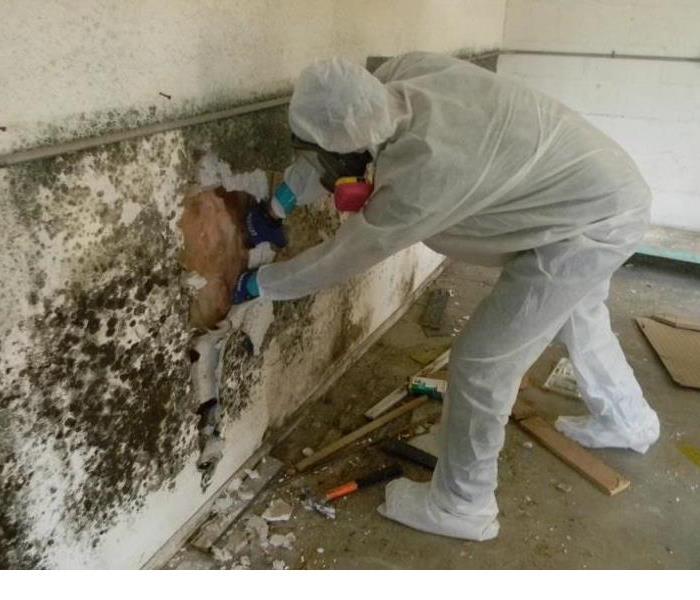 In Birmingham, mold can spread through a home in as little as 48 hours.
In Birmingham, mold can spread through a home in as little as 48 hours.
Microscopic mold spores naturally occur almost everywhere, both outdoors and indoors. This makes it impossible to remove all mold from a home or business. Therefore, mold remediation reduces the mold spore count back to its natural or baseline level. Some restoration businesses advertise “mold removal” and even guarantee to remove all mold, which is a fallacy. Consider the following mold facts:
- Mold is present almost everywhere, indoors and outdoors.
- Mold spores are microscopic and float along in the air and may enter your home through windows, doors, or AC/heating systems or even hitch a ride indoors on your clothing or a pet.
- Mold spores thrive on moisture. Mold spores can quickly grow into colonies when exposed to water. These colonies may produce allergens and irritants.
- Before mold remediation can begin, any sources of water or moisture must be addressed. Otherwise, the mold may return.
- Mold often produces a strong, musty odor and can lead you to possible mold problem areas.
- Even higher-than-normal indoor humidity can support mold growth. Keep indoor humidity below 45 percent.
If your home or business has a mold problem, we can inspect and assess your property and use our specialized training, equipment, and expertise to remediate your mold infestation.
If You See Signs of Mold, Call Us Today – 205-664-6770






 24/7 Emergency Service
24/7 Emergency Service

